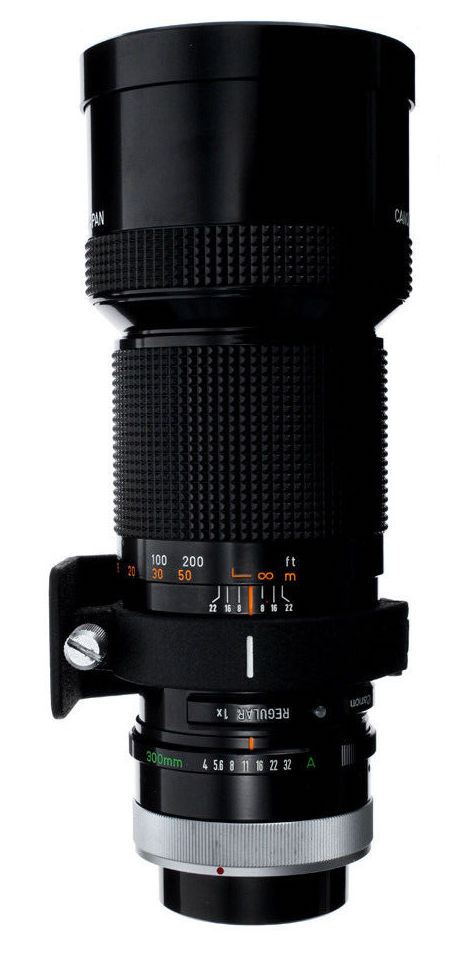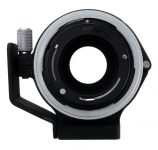Canon FD 300mm F/4 S.S.C.
Super telephoto prime lens • Film era • Discontinued
- Announced:
- · January 1978
- Production status:
- ● Discontinued
- Country of design:
- · Japan
- Original name:
- · CANON LENS FD 300mm 1:4 S.S.C.
- Class:
- · Slow full-frame super telephoto prime lens
- · Professional model
- System:
- · Canon FD (1971)
Abbreviations
| FD | The lens is designed for Canon 35mm film SLR cameras with the Canon FD mount. |
| S.S.C. | Multi-layer Super Spectra coating is applied to the surfaces of lens elements. This anti-reflection coating increases light transmission, eliminates flare and ghosting, and maintains color consistence among all lens models. |
Model history (2)
| ■Canon FD 300mm F/4 S.S.C. | A | 6 - 6 | 3.00m | -- | 1978 ● | |
| ■Canon FDn 300mm F/4 | A | 6 - 6 | 3.00m | -- | 1979 ● | |
Specification
| Optical design: | |
| 35mm full frame | |
| 300mm | |
| F/4 | |
| 6 elements in 6 groups | |
| Internal focusing (IF) | |
| Canon FD [42mm] | |
| 8.2° (35mm full frame) | |
| Diaphragm mechanism: | |
Diaphragm type: | Automatic |
Aperture control: | Aperture ring (Manual settings + Auto Exposure setting) |
| 9 (nine) | |
| Focusing: | |
| 3m | |
| 1:9.1 | |
Focusing modes: | Manual focus only |
Manual focus control: | Focusing ring |
| Physical characteristics: | |
| 965g | |
| ⌀85×204mm | |
| Accessories: | |
| Removable front filters are not accepted | |
Additional features: | Drop-in filter holder (34mm) |
| <No data> | |
| Canon Extender FD 1.4X-A → 420mm F/5.6 | |
| Canon Extender FD 2X-A → 600mm F/8 |
Source of data
- Manufacturer's technical data.
Manufacturer description
Through the use of original optical design technology, this new type of telephoto lens maintains high performance while achieving the brightness of f/4 aperture, reduced size and weight and excellent operability.
Like the FD300mm f/5.6 S.S.C. (released in March 1973), the FD400mm f/4.5 S.S.C. (released in October 1975), the FD600mm f/4.5 S.S.C. (released in July 1976) and the FD800mm f/5.6 S.S.C. (released in July 1976), which were highly regarded for high performance and excellent operability, this lens utilizes the rear focusing system in which focusing is performed by moving the rear lens group back and forth, resulting in being lightweight and compact as it does not change the overall length even when focusing. The lens has the closest focusing distance in its class at 3m, and also has excellent metering functions through the use of the vari-pitch focusing system.
With regard to optical performance, the lens realizes the ideal power distribution based on the latest in optics to properly compensate for aberrations. In particular, spherical aberration resulting from different wavelengths and aberration changes in close shooting have been almost completely eliminated through rear focusing, successfully providing excellent image quality with high resolution and high contrast despite the large aperture.
Other super telephoto prime lenses in the Canon FD system
| ■Canon FD mount (19) | |||||||||
| Canon FD 300mm F/5.6 | A | 6 - 5 | 4.00m | ⌀58 | 1971 ● | ||||
| Canon FD 300mm F/5.6 S.C. | A | 6 - 5 | 4.00m | ⌀58 | 1973 ● | ||||
| Canon FD 300mm F/5.6 S.S.C. | A | 6 - 5 | 3.00m | ⌀55 | 1977 ● | ||||
| Canon FDn 300mm F/5.6 | A | 6 - 5 | 3.00m | ⌀58 | 1979 ● | ||||
| Canon FD 300mm F/4L | A | 7 - 7 | 3.00m | -- | 1978 ● | ||||
| Canon FDn 300mm F/4 | A | 6 - 6 | 3.00m | -- | 1979 ● | ||||
| Canon FDn 300mm F/4L | A | 7 - 7 | 3.00m | -- | 1980 ● | ||||
| Canon FD 300mm F/2.8 S.S.C. Fluorite | A | 6 - 5 | 3.50m | -- | 1975 ● | ||||
| Canon FDn 300mm F/2.8L | A | 9 - 7 | 3.00m | -- | 1981 ● | ||||
| Canon FD 400mm F/4.5 S.S.C. | A | 6 - 5 | 4.00m | -- | 1975 ● | ||||
| Canon FDn 400mm F/4.5 | A | 6 - 5 | 4.00m | -- | 1981 ● | ||||
| Canon FDn 400mm F/2.8L | A | 11 - 9 | 4.00m | -- | 1981 ● | ||||
| Canon FD 500mm F/4.5L | A | 8 - 7 | 4.00m | -- | 1979 ● | ||||
| Canon FDn 500mm F/4.5L | A | 8 - 7 | 5.00m | -- | 1981 ● | ||||
| Canon FD 600mm F/4.5 S.S.C. | A | 6 - 5 | 8.00m | -- | 1976 ● | ||||
| Canon FDn 600mm F/4.5 | A | 6 - 5 | 8.00m | -- | 1981 ● | ||||
| Canon FD 800mm F/5.6 S.S.C. | A | 6 - 5 | 14.00m | -- | 1976 ● | ||||
| Canon FD 800mm F/5.6L | A | 7 - 6 | 14.00m | -- | 1979 ● | ||||
| Canon FDn 800mm F/5.6L | A | 7 - 6 | 14.00m | -- | 1981 ● | ||||
Lenses with similar focal length
Comments (4)
If this lens his manual focus only then why is there an (A) for automatic focussing on the lens?
Thank you very much.
All Canon FD lenses are manual focus only. “A” setting on the diaphragm ring means that the lens has automatic diaphragm control.
From the Canon A-1 SLR camera instructions:
“Shutter priority AE is especially useful in action photography, aperture priority AE in still photography. The programmed AE mode, in which the camera controls both aperture and shutter speed for correct exposure, is good for general use and is the easiest mode for beginners. These three AE modes along with exclusive flash AE, are performed with an FD lens set at “A” for all the benefits of full aperture metering.
<...> AE photography means automatic exposure. The camera is selecting either shutter speed or aperture or both for you.
<...> AE modes described above, i.e. shutter priority AE, aperture priority AE, programmed AE and AE flash photography, are performed with full aperture metering through the lens. This means that the diaphragm is fully open during metering for easiest viewing and operation.
For correct operation in these four full-aperture metering AE modes, only an FD lens can be used and the lens aperture ring must be set to the “A” mark.”.
Is there an adaptor that will allow this to work with a Canon Rebel T6s or D80? Would be used only for manual shots.
There are two types of adapters for mounting Canon FD lenses on SLR cameras: with and without magnifying glass. With glass adapter, the image quality will suffer, so it can’t really be recommended. With glassless adapter, you’ll loose the ability to focus at infinity due to the shorter flange focal distance of the Canon FD mount. The choice is yours but I would not bother at all trying to adapt Canon FD lenses on SLR cameras. The only right way to adapt them is to use a mirrorless camera.





